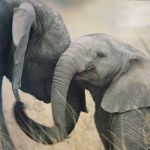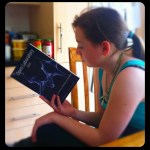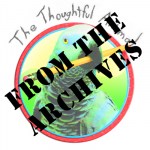
I was reading Christie's excellent post (and you should too) on GoDaddy CEO Bob Parsons' elephant killing incident (is it too early to be calling this #ElephantGate?)
Although I don't know quite enough about what is going on in Zimbabwe, I tend to err on the side of not intentionally killing elephants because - as I argued for the case of chimpanzees - they are very likely self-aware.
I wrote:
There is another important cognitive capacity that unites animals with high encephalization quotients (the ratio of brain to body size - I recommend going back to read my earlier post for the context…
Throughout the month of March, The Smithsonian Channel aired all-new original programming, exploring the scientific contributions of five female scientists: Elisabeth Blackburn, JoGayle Howard, Nan Hauser, Elisabeth Kalko, and Gudrun Pflueger. (I featured one of the programs, about Gudrun Pflueger, earlier this month.)
As the month of programming wraps up, in order to commemorate the Women in Science programming, and to celebrate Women in Science more generally, I've got some schwag from the Smithsonian Channel to give away to a reader!
The schwag package includes: the Smithsonian Channel…
Earlier this week, friend-of-the-blog and Open Lab 2010 finalist Stephen Curry tweeted this picture, with the caption "Reaching the next generation with #openlab"
This is why I do what I do.
...For a feature article in this week's Nature on how scientists go about developing and managing online personas. You can check out the article - for free - here. It's a good article, and you'll probably recognize some other familiar faces (e-faces? blog-faces?) in it as well.
While the interview, which I did back in the beginning of February, was enjoyable, I fear that my quotation in this article is slightly out of context. To be fair, I don't remember the exact course of the conversation I had with the writer - but here, I'll use my blog to make clear what I meant and ground my statement…
In case you haven't procured your copy of Open Lab yet, you might consider taking advantage of a Lulu site-wide sale.
If you place an order by March 31, and enter the discount code SPLISH305, you can get 20% off, up to $100.
Here is a direct link to the hard copy version of Open Lab 2010 on Lulu, and here is a direct link to the e-reader friendly version of Open Lab (and here are directions for adding the PDF to your e-reader device).
Here are my Research Blogging Editor's Selections for this week:
From Jon Brock at Cracking the Enigma: How do siblings influence theory of mind development in children with autism?
Did your gut bacteria make you read this post? From Mo at Neurophilosophy: Gut bacteria may influence thoughts and behaviour.
A short, but interesting, post from Dr. Shock: Is Sexting a Form of Attachment Anxiety?
Finally, from the eHarmony Labs: My partner and I are opposites. Now what?
A new piece by me today at the Scientific American Guest Blog, on some exciting news from the Jane Goodall Institute and Duke University:
Fifty years ago, in the summer of 1960 - the same year that a US satellite snapped the first photo of the Earth from space, the same year that the CERN particle accelerator became operational, the same year that the Beatles got their name - a 26-year-old Jane Goodall got on a plane in London and went for the first time to Gombe Stream Game Reserve, in Tanzania. She carried with her only a notebook and some old binoculars. Almost every day since the day…
Many people have inquired as to whether there is or will be an e-reader version of Open Lab. The short answer is: yes. But because of various technological constraints, the only e-book format available is PDF, and its already available.
Since the link for the PDF download is not especially obvious on the Lulu website, here is a direct link to the page to purchase the PDF version.
Okay, I downloaded the PDF, now how do I get it on my e-reader? Read on.
For the iPad, iPod Touch, or iPhone:
Open iTunes, and click "File," then "Add to Library." Navigate to the PDF file, and click "Choose." Now,…
I've got a new piece over at the Scientific American Guest Blog:
On Friday, March 11, Japan was rocked by an earthquake. People were displaced, a nuclear reactor was in trouble, and the world watched as a tsunami flooded Japan, threatened the islands of the Pacific, and ultimately hit the western coasts of North and South America. Chris Rowan pointed out that "Very little of the devastation resulting from this earthquake was from the initial shaking. This is partly because of Japan's stringent building codes. But mainly because any damage from the seismic waves that sent skyscrapers in Tokyo…
Here are my Research Blogging Editor's Selections for this week:
Dr. Sharma asks, at his eponymous blog, what are the psychological effects of exercise on adolescents?
M&Ms as a strategy to overcome fear of dogs. No, really. Neurocritic has the details.
Doctor Zen writes, "We're smart. Octopuses are smart. But we have different kinds of smart." Learn about it: Hand-hand-hand-hand-hand-hand-hand-hand-eye coordination.
You kept submitting your posts all year long and watching, every Monday, to see which other posts were also entered.
Then we closed the submission form.
Then we made you wait a month of "electoral silence" while the judges went through three rounds of judging, until we announced which 50 essays, plus poems and cartoons, made it into print.
Then, at Science Online, we announced the gorgeous new cover art.
But now - what you have been waiting for so long:
The Open Laboratory 2010, the collection of best writing on science blog for the year, is finally up for sale!
Buy one for yourself, buy…
Via the Smithsonian Channel:
Gudrun Pflueger, first seen in A Woman Among Wolves, returns to wolf country after a grueling and terrifying bout with cancer.
Determined to fight for the wolves who gave her the strength to survive her illness, Pflueger battles freezing temperatures and personal setbacks to track the wolves in the wild. The data she collects in the wolves' dwindling habitat may one day help stave off extinction of this keystone species. Witness the dramatic story of survival and endurance that culminates in nothing less than a scientific miracle.
Throughout the month of March…
Here are my Research Blogging Editor's Selections for this week:
What should you talk about on your first date if you want a second? Not films, apparently. Find some answers at the B Good Science Blog.
There is a period between "clinical death" and "brain death" called the "gap period," during which a person may not be breathing or have a pulse -- but still has (diminishing) neurological function. It is during this time that they might have what is called a "near death experience." Learn about it at The Genealogy of Religion blog.
There's good research on how teenagers perform on their…
Welcome to part 3 of the Science Blogging 101 series. You can find part 1 here, in which I discussed my own experiences with blogging, and part 2 here, which I discussed some of the big questions regarding audience, purpose, and so forth.
How do you balance blogging with the rest of your work? Do you see it as an extension or part of what you already do in keeping up with the literature or do you just enjoy blogging?
Well, I certainly enjoy blogging, otherwise I wouldn't do it. That said, blogging about research is a fantastic way to keep up on the literature. I read through (or, at least…
Watch this video and it might appear as if that beetle is being operated via remote control.
But wait. IT IS. The critter is a bit of a cyborg actually - part june bug, part computer. The man behind the zombie cyborg beetles is Michel Maharbiz, an associate professor in the Department of Electrical Engineering and Computer Science at the University of California, Berkeley. I met him last week at an event on the Science of Cyborgs organized by the Science and Entertainment Exchange.
When these arthropods are in the "pupa" stage, they get implanted with electrodes designed to stimulate the…
Welcome to the third installment of Animal Territoriality Week. See part 1 here, and part 2 here.
In 1994, a disease called sarcoptic mange swept through Bristol's fox population, severely crippling the population and killing most of the individuals. Professor Stephen Harris of the University of Bristol, who had been studying the movements and territories of those foxes, noticed that as the animals in one territory died, neighboring foxes were able to colonize the vacant areas in 3-4 days. He suspected that this was because the scent marks of the foxes remained active for 3-4 days, but didn'…
Welcome to the second installment of Animal Territoriality Week. Today, we'll look at a case where differences in territory size can have implications for neuroanatomy. If you missed part 1 of Animal Territoriality week, check it out here.
Let's say you have two very very closely related species. You might even call them congeneric, because they are from the same taxonomic genus. In most ways, these two species are very similar, but they differ behaviorally in some very big ways. Might those behavioral differences predict neurobiological differences?
The different species of the genus…
Here are my Research Blogging Editor's Selections for this week.
Embodied cognition never ceases to amaze and entertain. Mo Costandi of Neurophilosophy has the latest - Tough and tender: How touch affects sex categorization.
Emily Anthes of the Wonderland blog describes an interesting paper investigating the record-keeping of Dr. Harvey Cushing. Mistakes Were Made (Inside Your Brain)
From the Music Matters blog: Can Infants Recognize Melodies Heard in the Womb? The answer might surprise you.
Finally, Alex Konkel of the ionpsych blog tells us about the relationship between body and brain.…
Welcome to Territoriality Week! Every day this week, I'll have a post about some aspect of animal or human territoriality. How do animals mark and control their territories? What determines the size or shape of an animal's territory? What can an animal's territory tell us about neuroanatomy? Today, I begin by asking two questions: first, what is the functional purpose of establishing territories? Second, to what extent can we apply findings from research on animal territorial behavior to understanding human territorial behavior?
It seems that everyone becomes an amateur animal behaviorist…
The narrator laureate of the science world, David Attenborough, describes the birth of a baby grey kangaroo.
Our friends at BBC Earth describe the video:
In this video a kangaroo is born, crawls up to its mother's pouch where a camera captures it's development from tiny, naked, grub-like newborn into a fully grown Joey.
It's amazing how the baby worm-like kangaroo is born automatically knowing how to get up into the mother's pouch. Incredible.






